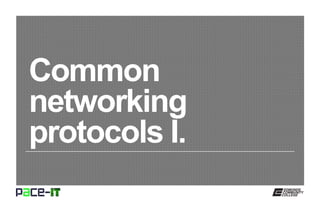
PACE-IT: Common Networking Potocols (part 1)
- 2. Page 2 Instructor, PACE-IT Program – Edmonds Community College Areas of Expertise Industry Certifications PC Hardware Network Administration IT Project Management Network Design User Training IT Troubleshooting Qualifications Summary Education M.B.A., IT Management, Western Governor’s University B.S., IT Security, Western Governor’s University Entrepreneur, executive leader, and proven manger with 10+ years of experience turning complex issues into efficient and effective solutions. Strengths include developing and mentoring diverse workforces, improving processes, analyzing business needs and creating the solutions required— with a focus on technology.
- 3. Page 3 – TCP and UDP. – Common ports and protocols. PACE-IT.
- 4. Page 4 Common networking protocols I.
- 5. Page 5 – TCP and UDP common factors. » Transport layer or Layer 4 protocols. • Responsible for the delivery of network data between nodes. – Transmission Control Protocol (TCP). » Reliable delivery method. » Ensures that all packets are received. » Uses acknowledgements as a means of error correction. » Establishes flow control to reduce error rate and ensure proper delivery. – User Datagram Protocol (UDP). » Best effort delivery method. » Sends data, but doesn’t care if the packets are all received. » No error correction. » Speed and low network overhead is what concerns UDP. Common networking protocols I.
- 6. Page 6 Common networking protocols I.
- 7. Page 7 – HTTP (Hypertext Transfer Protocol). » The primary protocol used to transfer data over the Internet. • Assigned to port 80. – HTTPS (Hypertext Transfer Protocol Secure). » The primary protocol to securely transfer data over the Internet using SSL (Secure Socket Layer) or TLS (Transport Layer Security) technology. In actuality, SSL should no longer be used. • Assigned to port 443. – NetBIOS (Network Basic Input/Output System). » Originally developed to allow hosts to be able to communicate with servers. • Assigned to ports 137-139. Common networking protocols I.
- 8. Page 8 – SMTP (Simple Mail Transfer Protocol). » The protocol used to transfer email from a client to an email server; it is also used to transfer email between servers. • Assigned to port 25. – POP3 (Post Office Protocol v3). » The protocol used by clients to retrieve email from servers. Once engaged, POP3 downloads all messages from the servers. The user cannot access email messages until they have been downloaded. • Assigned to port 110. – IMAP (Internet Message Access Protocol). » A protocol used by clients to access email on email servers. Allows the client to administer and organize email on the server into folders. • Assigned to port 143. Common networking protocols I.
- 9. Page 9 – SIP (Session Initiation Protocol) » A protocol that is most commonly used to set up and tear down multimedia communication sessions (e.g., a VoIP session uses SIP to establish and terminate the session). • Assigned to ports 5060 and 5061. – RTP (Real-time Transport Protocol). » The protocol that is commonly used to format and deliver multimedia or streaming content (e.g., RTP handles the flow of packets in a VoIP session after SIP has established the connection). • Assigned to ports 5004 and 5005. Common networking protocols I.
- 10. Page 10 – MGCP (Media Gateway Control Protocol). » A protocol that defines a means of communication between a packet switched network and circuit switched network (e.g., the PSTN). It can be used to set up, maintain, and terminate calls between multiple endpoints (e.g., teleconferencing). • Assigned to ports 2427 and 2727. – H.323. » A protocol that provides a standard for delivering video over IP networks. It defines how real-time audio, video, and data are to be transmitted. It provides signaling and bandwidth control. • Assigned to port 1720. Common networking protocols I.
- 11. Page 11 Common networking protocols I. TCP uses reliable delivery methods, while UDP uses best effort delivery methods. UDP has less overhead, but it also has no mechanism for error correction. Topic TCP and UDP. Summary Common ports and protocols include: HTTP (80), HTTPS (443), NetBIOS (137-139), SMTP (25), POP3 (110), IMAP (143), SIP (5060 and 5061), RTP (5004 and 5005), MGCP (2427 and 2727), and H.323 (1720). Common ports and protocols.
- 13. This workforce solution was 100 percent funded by a $3 million grant awarded by the U.S. Department of Labor's Employment and Training Administration. The solution was created by the grantee and does not necessarily reflect the official position of the U.S. Department of Labor. The Department of Labor makes no guarantees, warranties, or assurances of any kind, express or implied, with respect to such information, including any information on linked sites and including, but not limited to, accuracy of the information or its completeness, timeliness, usefulness, adequacy, continued availability or ownership. Funded by the Department of Labor, Employment and Training Administration, Grant #TC-23745-12-60-A-53. PACE-IT is an equal opportunity employer/program and auxiliary aids and services are available upon request to individuals with disabilities. For those that are hearing impaired, a video phone is available at the Services for Students with Disabilities (SSD) office in Mountlake Terrace Hall 159. Check www.edcc.edu/ssd for office hours. Call 425.354.3113 on a video phone for more information about the PACE-IT program. For any additional special accommodations needed, call the SSD office at 425.640.1814. Edmonds Community College does not discriminate on the basis of race; color; religion; national origin; sex; disability; sexual orientation; age; citizenship, marital, or veteran status; or genetic information in its programs and activities.
